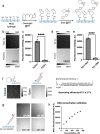All-Covalent Nuclease-Resistant and Hydrogel-Tethered DNA Hairpin Probes Map pN Cell Traction Forces
- PMID: 37409737
- PMCID: PMC10360067
- DOI: 10.1021/acsami.3c04826
All-Covalent Nuclease-Resistant and Hydrogel-Tethered DNA Hairpin Probes Map pN Cell Traction Forces
Abstract
Cells sense and respond to the physical properties of their environment through receptor-mediated signaling, a process known as mechanotransduction, which can modulate critical cellular functions such as proliferation, differentiation, and survival. At the molecular level, cell adhesion receptors, such as integrins, transmit piconewton (pN)-scale forces to the extracellular matrix, and the magnitude of the force plays a critical role in cell signaling. The most sensitive approach to measuring integrin forces involves DNA hairpin-based sensors, which are used to quantify and map forces in living cells. Despite the broad use of DNA hairpin sensors to study a variety of mechanotransduction processes, these sensors are typically anchored to rigid glass slides, which are orders of magnitude stiffer than the extracellular matrix and hence modulate native biological responses. Here, we have developed nuclease-resistant DNA hairpin probes that are all covalently tethered to PEG hydrogels to image cell traction forces on physiologically relevant substrate stiffness. Using HeLa cells as a model cell line, we show that the molecular forces transmitted by integrins are highly sensitive to the bulk modulus of the substrate, and cells cultured on the 6 and 13 kPa gels produced a greater number of hairpin unfolding events compared to the 2 kPa substrates. Tension signals are spatially colocalized with pY118-paxillin, confirming focal adhesion-mediated probe opening. Additionally, we found that integrin forces are greater than 5.8 pN but less than 19 pN on 13 kPa gels. This work provides a general strategy to integrate molecular tension probes into hydrogels, which can better mimic in vivo mechanotransduction.
Keywords: DNA hairpin sensors; DNA tension probes; hydrogel; integrin mechanosensing; mechanobiology; mechanotransduction.
Conflict of interest statement
The authors declare no competing financial interest.
Figures





Similar articles
-
Electrochemical DNA-based sensors for measuring cell-generated forces.Biosens Bioelectron. 2024 Jun 1;253:116185. doi: 10.1016/j.bios.2024.116185. Epub 2024 Mar 1. Biosens Bioelectron. 2024. PMID: 38457863 Free PMC article.
-
DNA Tension Probes Show that Cardiomyocyte Maturation Is Sensitive to the Piconewton Traction Forces Transmitted by Integrins.ACS Nano. 2022 Apr 26;16(4):5335-5348. doi: 10.1021/acsnano.1c04303. Epub 2022 Mar 24. ACS Nano. 2022. PMID: 35324164 Free PMC article.
-
Molecular Tension Probes for Imaging Forces at the Cell Surface.Acc Chem Res. 2017 Dec 19;50(12):2915-2924. doi: 10.1021/acs.accounts.7b00305. Epub 2017 Nov 21. Acc Chem Res. 2017. PMID: 29160067 Free PMC article. Review.
-
Programmable Multivalent DNA-Origami Tension Probes for Reporting Cellular Traction Forces.Nano Lett. 2018 Aug 8;18(8):4803-4811. doi: 10.1021/acs.nanolett.8b01374. Epub 2018 Jul 5. Nano Lett. 2018. PMID: 29911385 Free PMC article.
-
Molecular Tension Probes to Quantify Cell-Generated Mechanical Forces.Mol Cells. 2022 Jan 31;45(1):26-32. doi: 10.14348/molcells.2022.2049. Mol Cells. 2022. PMID: 35114645 Free PMC article. Review.
Cited by
-
Measuring integrin force loading rates using a two-step DNA tension sensor.bioRxiv [Preprint]. 2024 Mar 15:2024.03.15.585042. doi: 10.1101/2024.03.15.585042. bioRxiv. 2024. Update in: J Am Chem Soc. 2024 Aug 21;146(33):23034-23043. doi: 10.1021/jacs.4c03629. PMID: 38558970 Free PMC article. Updated. Preprint.
-
Electrochemical DNA-based sensors for measuring cell-generated forces.Biosens Bioelectron. 2024 Jun 1;253:116185. doi: 10.1016/j.bios.2024.116185. Epub 2024 Mar 1. Biosens Bioelectron. 2024. PMID: 38457863 Free PMC article.
-
Measuring Integrin Force Loading Rates Using a Two-Step DNA Tension Sensor.J Am Chem Soc. 2024 Aug 21;146(33):23034-23043. doi: 10.1021/jacs.4c03629. Epub 2024 Aug 12. J Am Chem Soc. 2024. PMID: 39133202 Free PMC article.
-
Nuclease-Resistant L-DNA Tension Probes Enable Long-Term Force Mapping of Single Cells and Cell Consortia.Angew Chem Int Ed Engl. 2024 Dec 9;63(50):e202413983. doi: 10.1002/anie.202413983. Epub 2024 Oct 25. Angew Chem Int Ed Engl. 2024. PMID: 39212256 Free PMC article.
-
A portable and sensitive DNA-based electrochemical sensor for detecting piconewton-scale cellular forces.Anal Chim Acta. 2025 Jan 2;1333:343392. doi: 10.1016/j.aca.2024.343392. Epub 2024 Nov 4. Anal Chim Acta. 2025. PMID: 39615910
References
MeSH terms
Substances
Grants and funding
LinkOut - more resources
Full Text Sources

